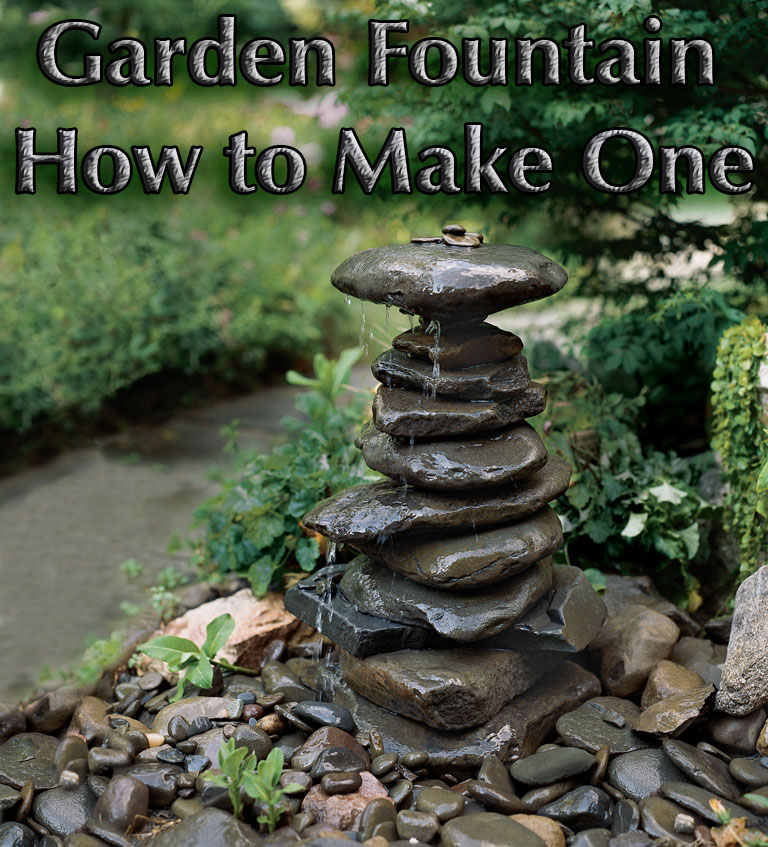
The project is nothing to get stressed about. In a mere weekend, you can fountain-ize most any leftover garden ornament, turning it into an enduring monument to tranquillity. Revive a defunct birdbath, declare your own ode to a Grecian urn, or drill holes in a stack of rocks you found on-site. When the job is finished and your fountain runneth over, you’ll rinse the tension from your bones in calm, cascading rivulets. Relaxation never seemed so easy.
Step 1 : Learn the anatomy and go to the store
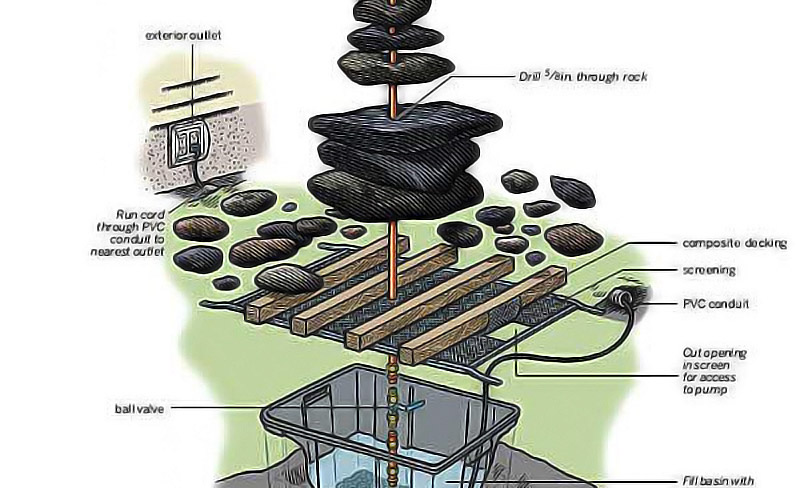
A fountain Is composed of three things: water, which flows up a pipe and trickles back down in a continuous cycle; a pump, which propels the water; and a piece of sculpture, over which the water flows. The sculpture can be built from any material that will withstand constant water. For the project shown here, we used large stones found on-site, but pavers, some metals, or pottery will all work.
Regardless of the fountain material, the guts of the system remain the same. It starts with a waterproof tub or basin that lines a hole in the ground to make a reservoir for the water. Above that is a rigid mesh screen that blocks large debris from getting into the tub. The screen is topped with a support system made from a strong but water-resistant material, such as composite decking, to keep the body of the fountain from falling into the basin.
The submersible pump is the heart of the system. It sits below the water line in the basin, recirculating and fine-filtering the runoff from above. Since the pump is electric, the fountain needs to be within reach of an exterior outlet—pump cords rarely reach beyond 50 feet, and manufacturers discourage the use of extension cords. It also needs to be accessible for maintenance after the fountain is built, so you’ll need to cut a trap door in the screen that’s big enough for you to reach in, unhook the pump, and pull it out. (The screen and support decking can be camouflaged with small stones or even mulch.) The pipe that carries the water to the top of the sculpture screws onto the pump. It also includes a small ball valve that will allow you to adjust the fountain’s flow, giving you the option of creating anything from a calming trickle to a formidable geyser.
Shopping List
- Pump Available at home or garden centers. Look for one labeled “submersible.” Pumps are rated in gallons per hour (gph), a measure of how much water they can handle and how high they can push it. Anything larger than 250 gph is overkill for a basic fountain with a ½-inch pipe.
- ½-Inch Copper Pipe to carry the water from the pump to the top of the fountain. Buy a piece 2 feet longer than your fountain’s height.
- Waterproof Basin such as a plastic storage bin, mason’s mortar-mixing bucket, or washtub, to hold the pump and collect the water. It should be 6 inches wider than the fountain base’s diameter and 1 foot taller than the pump so that it fits all the pipe connections while still keeping the pump submerged.
- Stones or other material to make the fountain body. Choose something that stacks easily; stones should have flat faces. The copper pipe will give some support, but the materials should stand well on their own.
- Small Rocks or large aggregate, such as terra-cotta shards or tumbled glass, to cover the top of the pit. One 5-gallon bucketful should be enough.
- ½-inch-by-½-inch Compression Female Adapter to connect the pipe to the pump.
- ½-inch Ball Valve to regulate the water flow.
- Screen to protect the pump from debris. A fiberglass or aluminum window screen or grille, or anything that comes in a rigid frame, is best. Get one big enough to span the basin.
- Composite Decking such as Trex or TimberTech, to support the fountain.
- Drainage Gravel for in and under the catch basin. Get two 50-pound bags.
- 1-inch PVC Conduit to carry the pump’s power cord underground to the outlet.
Step 2: Dig the pump hole
Using a pointed shovel, dig a pit 2 inches deeper than the basin and wide enough to fit it. Put the soil in a wheelbarrow or on a tarp to protect nearby turf. Dig a narrow, shallow trench between the pit and the nearest exterior outlet.
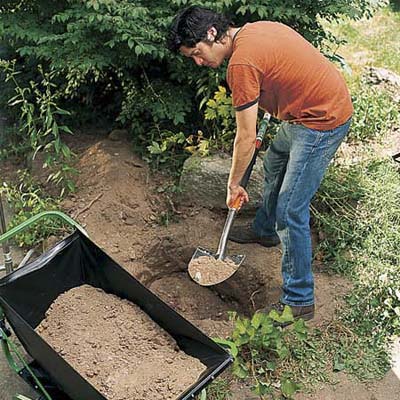
Step 3: Set the basin and conduit
Lay a 2-inch-thick bed of drainage gravel in the pit. Place the basin atop the gravel. If necessary, shift the gravel so the basin doesn’t rock. Measure the distance from the outlet to the edge of the pit. Cut a section of PVC conduit to this length. Thread a string through the conduit and tape one end of it to the pump’s plug. Pull the plug through the conduit. Tape the plug securely to the end of the conduit so it doesn’t get pulled back in. Lay the conduit in the trench and backfill over it.
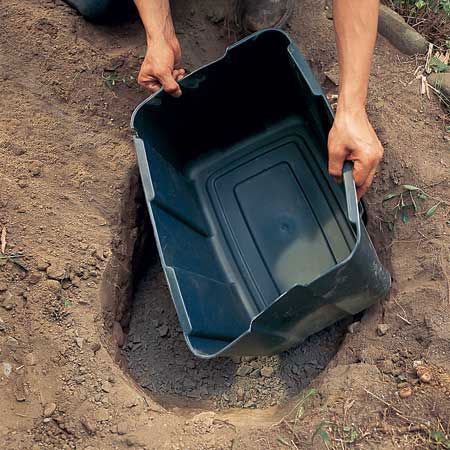
Step 4: Dry-fit the parts
Center the pump in the basin. Lay the screen over the pit and mark it at the spot directly over the threaded outlet on the pump. Also mark the screen at the edge closest to the conduit.
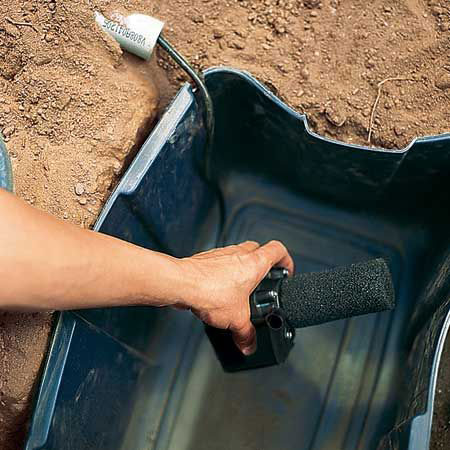
Step 5: Mark an opening
Using utility scissors, cut out a 1-inch-wide circle at the center mark. Then cut a three-sided flap at the conduit mark that is big enough to allow you to reach in and remove the pump for servicing
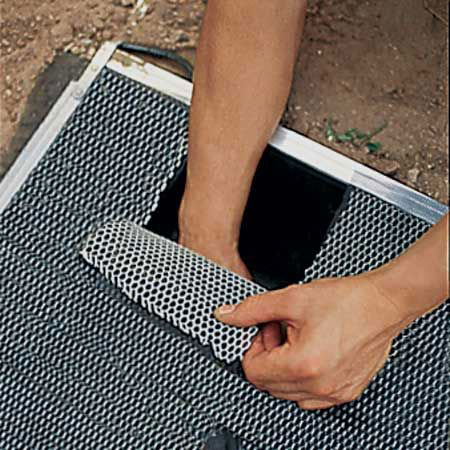
Step 6: Connect the pipe and pump
Using a pipe cutter, cut a 4-inch section off the end of the copper pipe. Unscrew the compression fittings on the ends of the ball valve. Slide a nut from the ball valve, then the brass ring, or ferrule, onto the long section of pipe. Insert the pipe into one end of the ball valve, then finger-tighten the nut over the ferrule onto the valve. Attach the short section of pipe to the other end of the valve in the same manner.
Screw the threaded end of the adapter onto the pump outlet. Take apart the compression end and slide the nut, then the ferrule, over the short section of pipe. Connect the pipe to the pump with the compression fitting. Using an adjustable wrench, tighten all three compression nuts an extra quarter-turn.
Pour a 2-inch layer of drainage gravel in the bottom of the basin. Lay the pump in the center of the basin with the pipe sticking up. Slide the screen over the pipe and arrange it so the access flap is near the conduit.
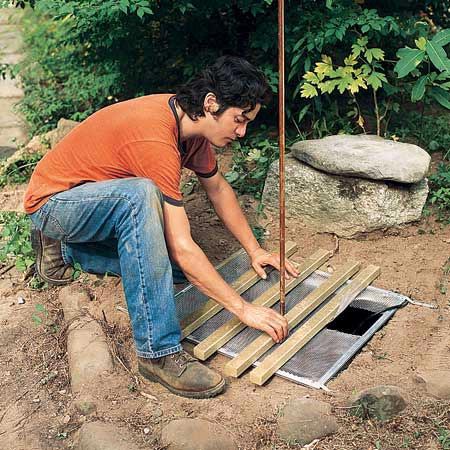
Step 7: Fit the decking
Using a handsaw, cut sections of decking long enough to extend beyond the pit a few inches on either side. Lay the decking across the pit on top of the screen.
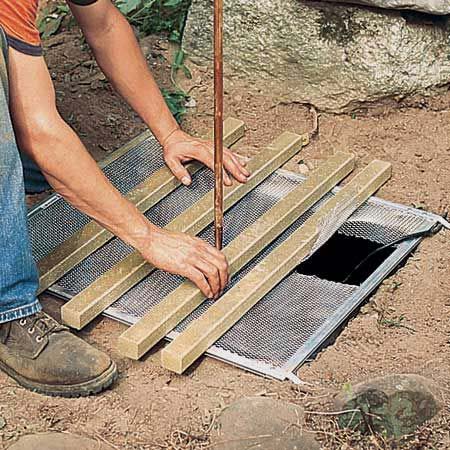
Step 8: Drill the stones
Stack the stones to create an aesthetically pleasing arrangement. Number the underside of each stone in pencil to keep track of the order as you unstack them. Lay a stone on soft ground or gravel. Using a hammer drill fitted with a 5⁄8-inch masonry bit, drill through the flat side of the stone. Repeat for all the stones.
Tip: Keep a bucket of water near the drill. Intermittently pour some on the stone to keep it wet—and the drill bits cool—as you work.
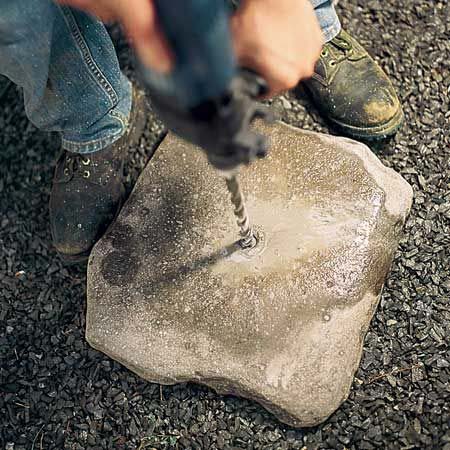
Step 9: Assemble the fountain
Thread the stones over the copper pipe until they’re stacked and balanced. Mark the pipe where the stones end. Remove the top stone and use a pipe cutter to cut the copper pipe 1/4 inch below the mark. Replace the stone.
Fill the bin from a garden hose, adding enough water to rise 5 inches above the pump. Open the ball valve, plug in the pump, turn it on, and check the flow. Adjust the pressure with the ball valve.
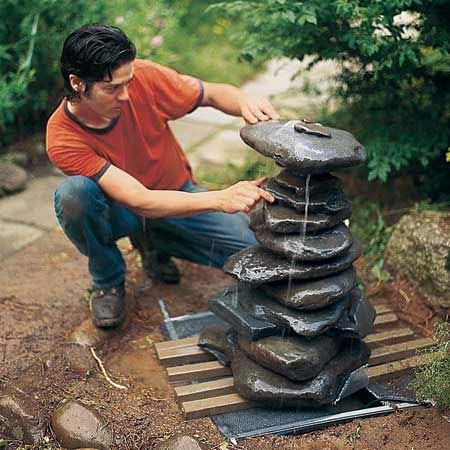
Step 10: Finish up
Direct the water by spinning stacked stones. Wedge smaller stones into the gaps to keep the structure stable. To make the arrangement permanent, turn off the water and squeeze dabsof clear silicone adhesive between the stones. Allow the adhesive to dry before you turn on the fountain again. Once the fountain flows the way you’d like it to, close the screen and camouflage the base with small stones.
Tip: Check the basin’s water level regularly—especially in a heat wave—and replenish it to keep the pump constantly submerged.

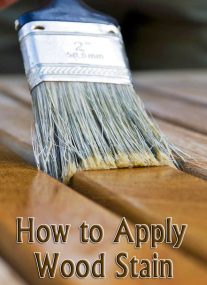

This seems like a really cute backyard fountain for a garden! That is interesting that you used real stones to do this with. How hard was it to drill through the smaller stones without breaking them?